Krak des Chevaliers: one of the best fortresses of the Middle Ages
The closest major city to the fortress is Syrian Homs, which is located 65 kilometers away to the east of the castle. In 2006, this fortress, along with the citadel of Saladin (located in 30 kilometers east of Lattakia), was listed as a UNESCO World Heritage Site. However, this could not save the fortress. She, as in the Middle Ages, again became the scene of fighting in the XXI century during the civil war in Syria, the fortress was repulsed by government forces in March of 2014. During the fighting, the old fortress was damaged.
History This fortress originates from the end of the XI century. The first mentions of the fortress are in the Muslim chronicles, in which it is called the “Fortress of the Kurds” (Hisn al-Akrad). Since 1031, on the orders of the Amir of Aleppo, the Kurdish garrison has been located here. During the First Crusade in 1099, the crusaders managed to capture the fortress, which was done by Raymond of Saint-Gilles. However, quickly enough, the Crusaders simply left the captured object, continuing their march on Jerusalem. At that time, everyone was so embraced by the idea of mastering the Holy City that the small Kurdish castle simply remained “ownerless”.
As a result, the fortress had to be re-taken, finally it was returned only in 1110, when Krak des Chevaliers was recaptured from the Kurds a second time. At that time, the contents of the castle required a significant investment of funds and forces, so until 1142, almost no one was engaged. Only after the castle was handed over to the Hospitaller Order in 1142 did the fortress begin to develop. It was the Knights of the Order of the Hospitallers who created that masterpiece of fortification, which has been preserved to our days and to the well-known events in Syria attracted the attention of thousands of tourists from all over the world.
Thanks to this acquisition, the Order, which was also called the John of John, was able to expand its influence right up to Lake Homs in the east. Johannites rebuilt the castle, turning it into the largest and most impregnable fortress of the Holy Land. It is worth noting that the Hospitallers invested huge sums in those times for the reconstruction and construction of the fortress. Thus, the new owners managed to build a new external wall with a thickness from 3 to 30 meters, adding watchtowers to the 7 fortress. Restructuring and modernization led to the fact that the Krak des Chevaliers fortress became the largest stronghold of Christianity in the entire Middle East. Already by 1200, this fortress could easily accommodate a garrison of thousands of people in 2 and a huge amount of provisions. Thanks to this, the defenders of the castle were able to withstand sieges for years. The whole history of this fortress proves its inaccessibility. For all the time, the fortress was taken only once in 1271, and then only thanks to deception.
It was thanks to the Hospitallers that the rather modest castle of the Kurds eventually grew to a truly fortified complex, surrounded by a thick multi-meter wall of solid masonry. One of the towers built in the fortress was held personally by the Grand Master of the Order of the Knights of Malta. The fortress included a developed network of courtyards, numerous storehouses for supplies, hidden inside the cliffs, including a huge 120-meter hall in which stolen riches were kept, as well as a reservoir with water reserves. The Hospitallers did everything so that the castle was able to withstand any, even the longest siege, creating one of the most impregnable fortresses of the Middle Ages.
Muslim troops many times came under the walls of the fortress in order to expel aliens from their native lands, having made many attempts to take the castle by attack and at the same time losing thousands of soldiers. All these attempts were unsuccessful. The fortress could not be successfully stormed and could not be destroyed. Thanks to the strength of the walls, the Hospitallers in 1188 were able to repel the attack on the castle of Saladin himself, a Muslim warrior who liberated Jerusalem and was considered invincible. However, even the legendary Saladin failed to do anything with the Krak des Chevaliers, retreating from the walls of the fortress with nothing.
The Hospitallers kept the fortress until the general situation decisively contributed to the expulsion of Christians from the Holy Land. A strong ruler, like Sultan Beibars, in the middle of the 13th century, managed to unite Egypt and Syria. He literally flooded his district with his troops, cut supply lines, and Muslim settlements stopped paying tribute to the Krak des Chevaliers fortress. This was the beginning of the end. However, the Maltese knights were going to fight in the fortress to the last man, refusing to lay down weapon. At the same time, Mamluk and Ibn Shaddad came to the aid of Beibars. In 1271, the fortress, surrounded on all sides by hordes of enemies, took its last battle.
Numerous siege engines and undermining did their job - the troops besieging the fortress, even at the cost of huge losses, managed to break through the outer walls of the fortress. However, the garrison fought bravely: the knights retreated inside the fortress, into the towers and flatly refused to surrender. The capture of the courtyard of the fortress promised many victims, so Beybars ordered to stop the battle. He decided to use cunning: a fake letter was sent to the surviving knights, defenders of the fortress on behalf of the Master of Maltese from Tripoli, the letter contained permission to surrender the fortress. Only after this letter were the remnants of the knight garrison able to leave their refuge and surrendered to the victors. At the same time, Beibars showed magnanimity, without executing the knights who had surrendered. They were all released. Having gone back to France, they were exposed to numerous dangers along the way, but some of them still managed to return to Europe unharmed. After that, the Muslims made the castle Krak des Chevaliers with their fortress, managed to restore the towers destroyed during the siege, and added new ones. Currently, the castle is a mixture of Christian and Muslim built from different time periods. Thus, during the reign of Mamluk, the southern wall was strengthened, several new buildings were added, including an aqueduct and a Turkish bath.
Architecture of the Krak des Chevaliers fortress
The location of the castle itself was largely decisive for its defensive architecture. The castle is located on an elongated hilltop. Repeating the shape of the top, the castle in the plan has the form of a trapezoid with the top, which is directed to the north, and the base, which is oriented to the south. The length of its sides is about 200 meters, the base width is about 150 meters. Thus, the total area of the space inside the walls of the castle does not exceed 2,5 ha. Nature itself reliably defended the castle against the besieging enemy. From the east, west and north, the steep slopes of the hill, which make the fortress almost impregnable. Only from the south side, where the ridge projection communicates with the adjacent neighboring hill, could the enemy break camp, set up his siege vehicles and launch an attack on the fortress. The defenders of the Krak des Chevaliers tried to reduce the danger by digging a ridge with several lines of ditches and erecting a triangular scraper. The line of walls on the south side had a maximum width; it was here that the tallest and most powerful towers were placed.
Like the numerous fortifications of that time period, the Krak des Chevaliers was built gradually over several centuries. Initially, the castle was a rather weak fortification, possessing a single tower. In the course of the subsequent construction work, the castle acquired first one and then two belts of walls with towers, which ledges towered above each other. Such fortifications belong to the so-called concentric type, since their defense is consistently built on several levels. The road leading to the castle passed under the walls of the outer defense belt, while access to the inside of the fortress fortifications was carried out along a narrow corridor at the foot of the second-level walls. Even breaking through the outer wall, the enemy had to overcome many more obstacles in order to penetrate inside the citadel.
Inside the castle, the besiegers would meet various traps. All the corridors inside were shot in several directions, and the aisles could be blocked by bars falling from above. The path to the gate was built in such a way that it was possible to move along it only by turning to the wall with the right side not protected by a shield. The dead zone, located at the foot of the fortifications, was shot from the box-like protrusions of machiclaums hung on the wall. Mashikuly - mounted loopholes, which are located at the top of the fortress towers and walls. Basically, they are intended for vertical shelling of the assault forces of the enemy, as well as throwing stones at them.
Architectural features:
1. Line of defense. The fortress fortification system consisted of two concentric circles of fairly thick walls. The outer walls were defended from the territory of the lower courtyard, and the defenders of the internal fortifications of the fortress fought off the attackers from the towers and from the territory of the upper courtyard. The castle was surrounded by a moat, and drinking water supplies, in case of a long siege, were kept in special tanks located in the lower courtyard. When, in 1271, the troops of the Egyptian Sultan Beibars were able to break through the outer ring of fortifications and penetrate the lower courtyard, they failed to advance further. As a result, the fortress, as noted above, was taken as cunning.
2. Support towers. The massive walls of the fortress were fortified with supporting towers, which served as a reliable shelter for the sentinel soldiers.
3. Outer wall The beveled thickening located at the base of the wall protected it from possible digging or detonation.
4. Loopholes. The narrow slits of the loopholes of the castle were practically invulnerable to the shells, they usually expanded inward, forming a niche in the wall. From there the archers of the garrison could watch the enemy and, aiming, shoot.
5. Internal communication. The Crusaders could use pigeon-mail, which they borrowed from the Arabs, to communicate between various fortifications located at a distance from each other.
6. Aqueduct. After the next reconstruction, the water began to flow into the castle through an aqueduct. But in case of a long siege inside the fortress, water was accumulated, which was stored in dungeons in closed tanks.
7. Square tower During the siege in 1271, this tower was seriously damaged, so it had to be rebuilt, the works were completed in 14 years. At the same time round towers were considered more reliable in terms of defensive actions.
8. Vaulted galleries. A vaulted gallery stretched along the walls of the refectory - it was possible to hide from the rays of the scorching sun. In the courtyard were the most comfortable and beautiful rooms of the castle - the chambers of the knights. The courtyard was a refuge for the inhabitants of the castle in the event of an attack or siege, guarding the outer wall of the fortress.
9. Outbuildings. In the dungeons of the upper courtyard there were roomy storerooms. A windmill could be installed at one of the towers - the accumulated reserves of flour made it possible to withstand very long sieges.
10. Upper tier. The defense of the upper tier of the fortifications of the fortress rested on high towers and a courtyard, in which there were dormitories (bedrooms), a refectory, a chapel, the chambers of knights, and also warehouses.
11. Additional insurance. The walls of the upper tier of the fortress were reinforced with a powerful thickening in the form of a slope. The width of this thickening was up to 24,3 meters, which was almost equal to the height of the walls themselves. Such a massive structure was added in the 13th century. In addition to her defensive function, she served as a huge buttress, having survived more than one earthquake.
12. Tricks of defense. From the eastern gate tower of the castle to the donjon led ramps, which replaced the stair flights. A tight, winding passage interfered with firing from the battering ram. Even abrupt changes of light and shadow could be confusing.
By the 21st century, the castle managed to preserve the main part of its architectural grandeur, which managed to conquer the hearts of many travelers of past centuries. The external buildings of this medieval fortress suffered because of numerous sieges and battles, but the interior was preserved almost in its original form. On the territory of the castle Krak des Chevaliers today you can see the church, kitchen, storage rooms, residential and weapon rooms. At the same time, the fortress is located on a hill, from where a great view of the nearby surroundings opens. All this before the outbreak of hostilities in Syria attracted thousands of tourists from all over the world.
Information sources:
http://masterok.livejournal.com/1478534.html
http://www.allcastles.ru/syria/krak-des-chevaliers.html
http://warspot.ru/3848-krak-de-shevalie-chudo-srednevekovoy-fortifikatsii
http://phototravelguide.ru/dvorcy-zamki-kreposti/krak-de-shevale
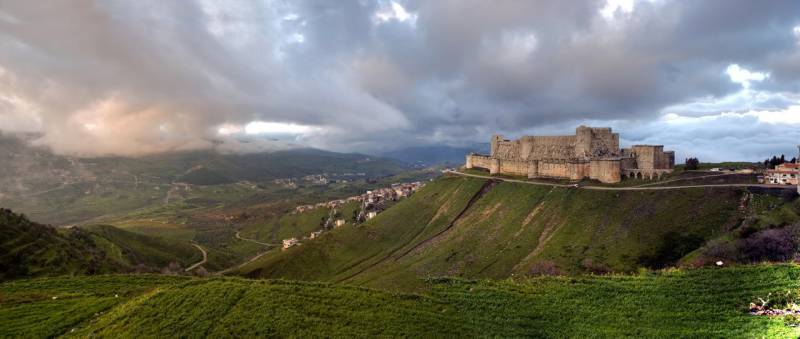
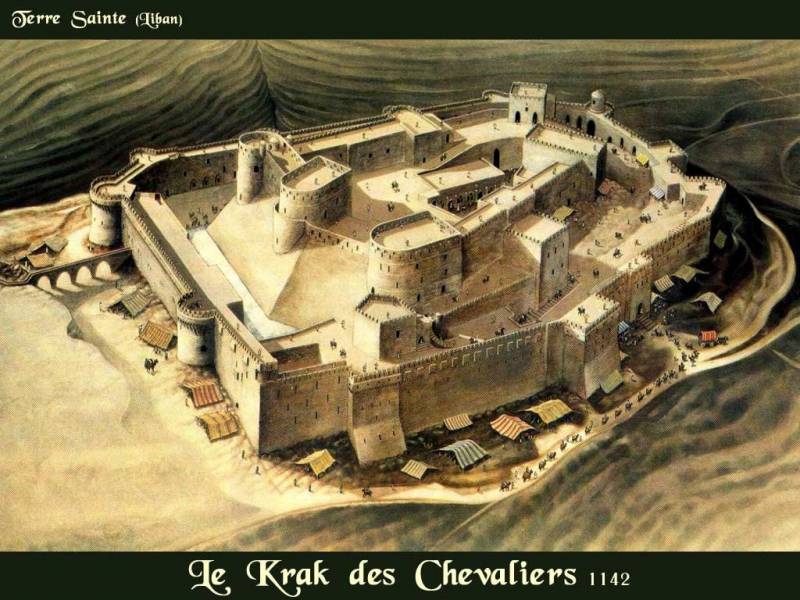
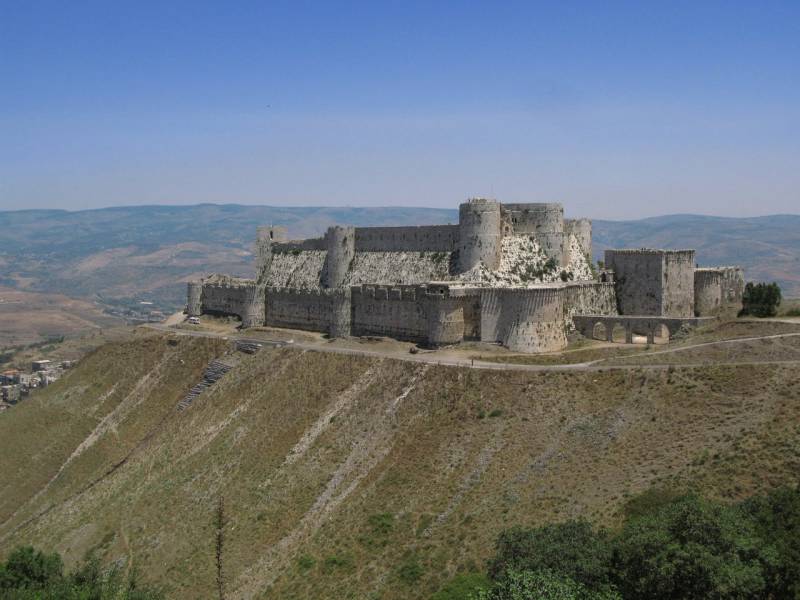
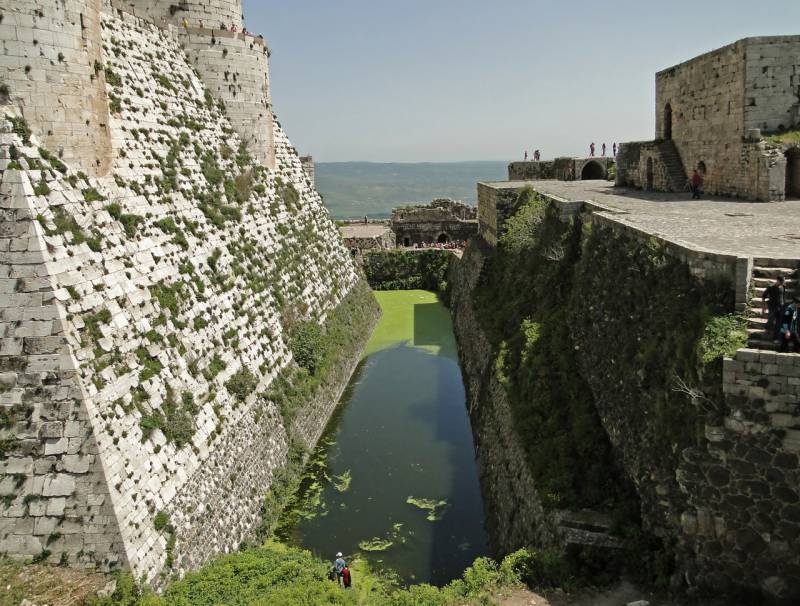
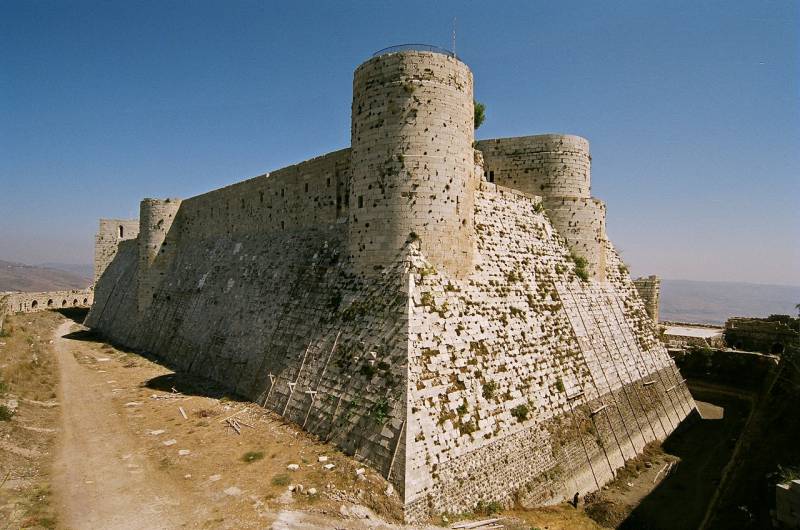
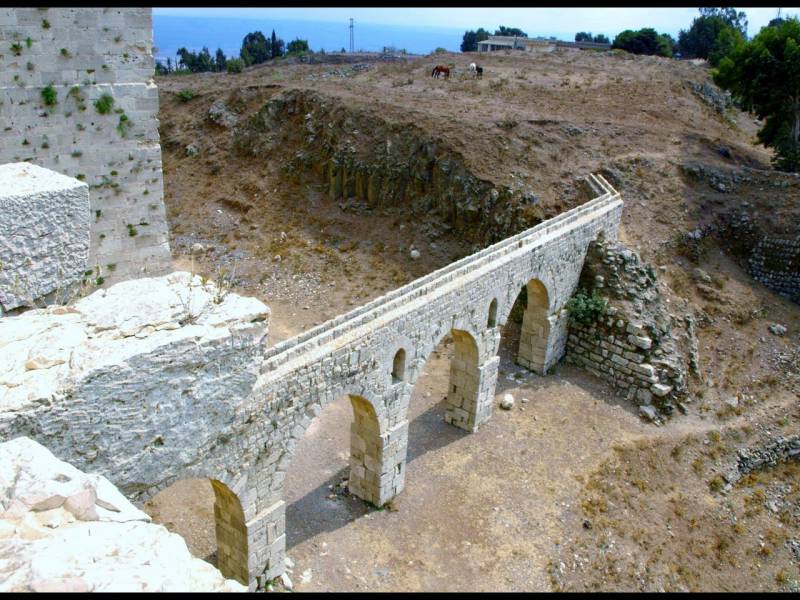
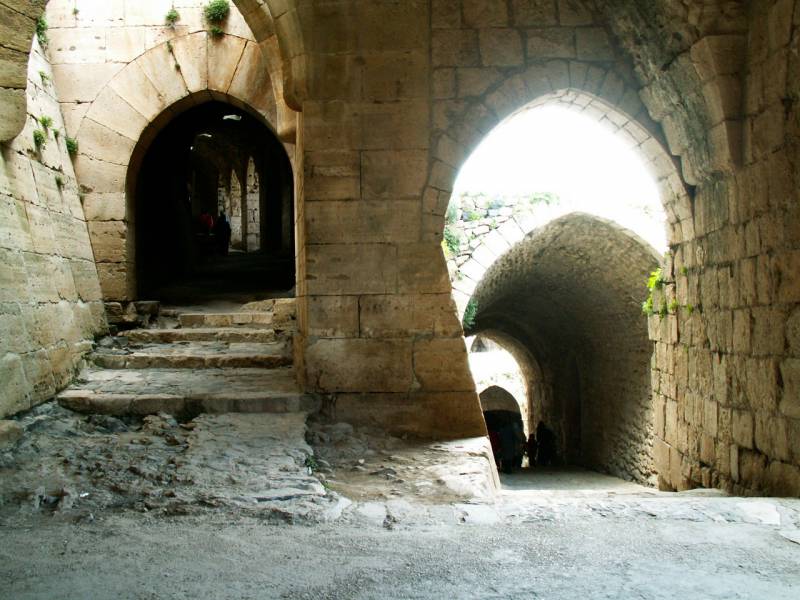
Information